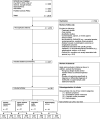Differential Diagnosis of Apraxia of Speech in Children and Adults: A Scoping Review
- PMID: 32783767
- PMCID: PMC7890226
- DOI: 10.1044/2020_JSLHR-20-00061
Differential Diagnosis of Apraxia of Speech in Children and Adults: A Scoping Review
Abstract
Purpose Despite having distinct etiologies, acquired apraxia of speech (AOS) and childhood apraxia of speech (CAS) share the same central diagnostic challenge (i.e., isolating markers specific to an impairment in speech motor planning/programming). The purpose of this review was to evaluate and compare the state of the evidence on approaches to differential diagnosis for AOS and CAS and to identify gaps in each literature that could provide directions for future research aimed to improve clinical diagnosis of these disorders. Method We conducted a scoping review of literature published between 1997 and 2019, following the Preferred Reporting Items for Systematic Reviews and Meta-Analyses Extension for Scoping Reviews guidelines. For both AOS and CAS, literature was charted and summarized around four main methodological approaches to diagnosis: speech symptoms, quantitative speech measures, impaired linguistic-motor processes, and neuroimaging. Results Results showed that similar methodological approaches have been used to study differential diagnosis of apraxia of speech in adults and children; however, the specific measures that have received the most research attention differ between AOS and CAS. Several promising candidate markers for AOS and CAS have been identified; however, few studies report metrics that can be used to assess their diagnostic accuracy. Conclusions Over the past two decades, there has been a proliferation of research identifying potential diagnostic markers of AOS and CAS. In order to improve clinical diagnosis of AOS and CAS, there is a need for studies testing the diagnostic accuracy of multiple candidate markers, better control over language impairment comorbidity, more inclusion of speech-disordered control groups, and an increased focus on translational work moving toward clinical implementation of promising measures.
Figures



References
-
- American Speech-Language-Hearing Association. (2007). Childhood apraxia of speech [Position statement]. http://www.asha.org/policy
-
- Arksey, H. , & O'Malley, L. (2005). Scoping studies: Towards a methodological framework. International Journal of Social Research Methodology, 8(1), 19–32. https://doi.org/10.1080/1364557032000119616
-
- Ash, S. , McMillan, C. , Gunawardena, D. , Avants, B. , Morgan, B. , Khan, A. , Moore, P. , Gee, J. , & Grossman, M. (2010). Speech errors in progressive non-fluent aphasia. Brain and Language, 113(1), 13–20. https://doi.org/10.1016/j.bandl.2009.12.001 - PMC - PubMed
-
- Aziz, A. A. , Shohdi, S. , Osman, D. M. , & Habib, E. I. (2010). Childhood apraxia of speech and multiple phonological disorders in Cairo-Egyptian Arabic speaking children: Language, speech, and oro-motor differences. International Journal of Pediatric Otorhinolaryngology, 74(6), 578–585. https://doi.org/10.1016/j.ijporl.2010.02.003 - PubMed
-
- Bahr, R. H. (2005). Differential diagnosis of severe speech disorders using speech gestures. Topics in Language Disorders, 25(3), 254–286. https://doi.org/10.1097/00011363-200507000-00008
Publication types
MeSH terms
Grants and funding
LinkOut - more resources
Full Text Sources
Miscellaneous

